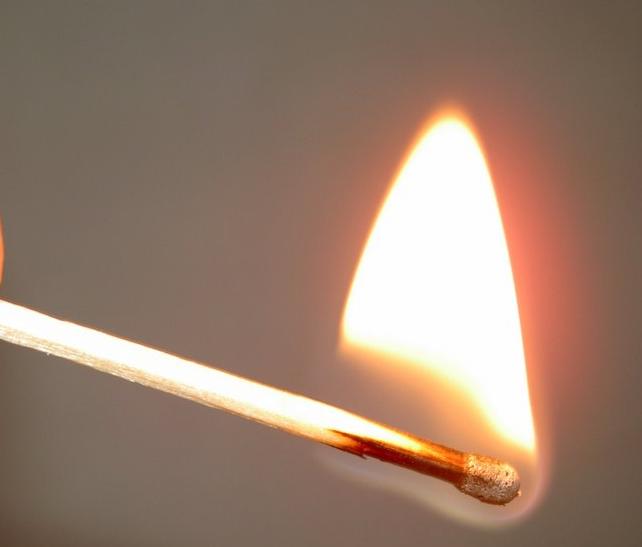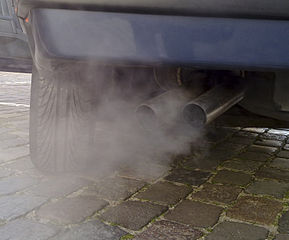1. Introduction
In the last tutorial, we looked at
- what energy is,
- some key forms of energy, and
- how energy can be transformed from one form to another.
In this tutorial, we’ll look at how living things can power their life processes by using the chemical energy of ATP: life’s energy carrier.
2. Releasing chemical energy through combustion

Before looking at ATP, let’s take a look at how chemical energy gets released in some systems that aren’t alive, where what happens is much simpler.
One way to release stored chemical energy is combustion. Combustion is what happens when wood burns. Here’s the chemical equation.
WOOD + oxygen → energy (heat and light) + carbon dioxide + water
What this means is that the molecules in the wood combine with oxygen in the air. This releases heat and light energy, along with two waste products: carbon dioxide (CO2) and water (H2O). Carbon dioxide is a colorless and odorless gas. The water released is in the form of water vapor, or steam.

Burning gasoline in a car is also combustion.
Gasoline + oxygen → energy (heat) + carbon dioxide + water
The car’s engine transforms the heat into kinetic energy (motion). If you stand behind a car on a cold day, you can see the water released as steam going into the air.
Let’s see if you can complete the missing parts in the chemical reaction below.
[qwiz qrecord_id=”sciencemusicvideosMeister1961-HSenergy, combustion”]
[h]Checking Understanding: Combustion
[q labels=”top”] Note: not every term below has to be used to answer this question.
_______ + oxygen → energy (heat) + ________ + water
[l]energy
[fx] No. Please try again.
[f*] Great!
[l]CO2
[fx] No, that’s not correct. Please try again.
[f*] Excellent!
[l]fuel
[fx] No, that’s not correct. Please try again.
[f*] Excellent!
[q labels = “top”]
FUEL + _________ → energy + carbon dioxide + _______
[l]oxygen
[fx] No, that’s not correct. Please try again.
[f*] Correct!
[l]water
[fx] No, that’s not correct. Please try again.
[f*] Good!
[/qwiz]
3. In cells, food energy gets transformed into ATP

In a car, the engine combusts a fuel like gasoline, transforming the chemical energy in the fuel into heat. Then the heat is transformed into energy of motion.
In living cells, things are more complex. In animals like us, the fuel comes from food, and to make the energy in food available for cellular work, cells first have to transform the chemical bonds in food into another molecule: ATP.
Based on your previous studies of molecules like DNA and RNA, you already know a lot about ATP. ATP is a nucleotide—one of the monomers that make up nucleic acids. Its full name is adenosine triphosphate.
ATP’s structural formula is shown below. Note that in this type of structural formula, you have to imagine a carbon atom at every angle. For example, in the nitrogen-containing group shown at (2), there are 5 carbon atoms. Take a good look at this molecule, and see if you can label its three main parts.
[qwiz qrecord_id=”sciencemusicvideosMeister1961-HSenergy, ATP diagram”]
[h]Interactive Diagram: ATP
[q labels = “top”]
[l]adenine (nitrogenous base)
[fx] No. Please try again.
[f*] Great!
[l]three phosphate groups
[fx] No. Please try again.
[f*] Excellent!
[l]ribose sugar
[fx] No. Please try again.
[f*] Great!
[/qwiz]
Let’s look at ATP in a bit more detail. First, you can see why it’s called adenosine triphosphate. “Adenosine” comes from the nitrogenous base adenine (number 2 in the diagram). The “triphosphate” is from the three phosphate groups (shown at number 3 in the diagram). Part 1 is a five-carbon sugar called ribose.
The three phosphate groups (part 3) are what enable ATP to store and release energy. Each phosphate group consists of one phosphorus atom surrounded by oxygen atoms. As you can see in this diagram, the oxygen on the bottom has a negative charge. Negative charges repel one another, and that makes breaking the bonds between the phosphates relatively easy for enzymes to do. In other words, it only takes a small amount of energy to break the bond that holds the third phosphate in ATP onto the rest of the molecule. When that phosphate is placed onto another molecule, energy is release for cellular work. That’s how you move your muscles. It’s how your nerve cells set themselves up to send impulses, which allows you to do the thinking that you’re doing now.
4. The ATP/ADP cycle is how cells release and store energy
When a cell needs to release a bit of energy to get some work done, it will, usually through the action of an enzyme, break off the last phosphate in ATP, and place that phosphate onto another molecule. This releases a small amount of energy, and transforms ATP into its counterpart, ADP. ADP stands for Adenosine diphosphate. As you can see below, ADP has two phosphate groups.
Here’s the structure of ATP and ADP, side by side. Note that the last phosphate group in ATP or ADP can be shown in two ways. Sometimes it’s shown with a charge. You’ll see this as —O–. It can also be shown without a charge. You’ll see this as —OH. Below, ATP is shown in its uncharged form (with an -OH group on its last phosphate). ADP is shown in its charged form (note the oxygen with a minus sign). In textbooks and tests you can see either form, so get used to seeing both.

You can think of ADP as a rechargeable battery that has run out of energy. ATP, with its three phosphates, is like a fully charged up battery, ready to power whatever it is you want to do.
ATP and ADP are linked in a cycle. See if by analyzing what you see below you can figure out the parts.
[qwiz qrecord_id=”sciencemusicvideosMeister1961-HSenergy, ATP/ADP cycle”]
[h]Interactive Diagram: ATP/ADP Cycle
[q labels = “top”]
[l]ADP
[fx] No. Please try again.
[f*] Correct!
[l]ATP
[fx] No. Please try again.
[f*] Excellent!
[l]Energy from food
[fx] No, that’s not correct. Please try again.
[f*] Great!
[l]Energy released for work
[fx] No, that’s not correct. Please try again.
[f*] Correct!
[l]Phosphate group
[fx] No, that’s not correct. Please try again.
[f*] Correct!
[/qwiz]
Cells convert ATP into ADP and phosphate in order to do some work. For example, when you’re kicking a ball, the contraction of your muscles is powered by conversion of trillions of ATPs into ADP and phosphate. And this is made possible by the food you eat, which powers the creation of ADP and P into ATP.
5. Checking Understanding
In the next unit, we’ll look at how cells make ATP through a process cellular respiration. But for now, make sure you’ve got the big picture by taking the quiz below.
[qwiz random = “true” qrecord_id=”sciencemusicvideosMeister1961-HSenergy, combustion, ATP, ADP”]
[h]Quiz: Combustion, ATP, ADP
[q topic= “ATP”]When you strike a match, the chemical energy in the match is released in the form of
[c]IEFEUA==[Qq]
[c]IEhlYXQgYW 5kIGxpZ2h0[Qq]
[c]IGNhcmJvbiBkaW94aWRl[Qq]
[f]IE5vLiBTdHJpa2luZyBhIG1hdGNoIGlzIGFuIGV4YW1wbGUgb2YgY29tYnVzdGlvbi4gQURQIGlzIHByb2R1Y2VkIHdoZW4gQVRQIGlzIHVzZWQgYnkgY2VsbHMuIFdoYXQgZG8geW91IHNlZSBhbmQgZmVlbCBmcm9tIGEgbGlnaHRlZCBtYXRjaD8=[Qq]
[f]IENvcnJlY3QuIFRoaXMgaXMgYW4gZXhhbXBsZSBvZiBjb21idXN0aW9uLCBhbmQgdGhlIGVuZXJneSBpcyByZWxlYXNlZCBhcyBoZWF0IGFuZCBsaWdodC4=[Qq]
[f]IE5vLiBDYXJib24gZGlveGlkZSBpcyBvbmUgb2YgdGhlIHdhc3RlIHByb2R1Y3RzIG9mIGEgY29tYnVzdGlvbiByZWFjdGlvbiwgYnV0IGl04oCZcyBub3QgZW5lcmd5ICYjODIxMTsgaXTigJlzIGFuIGV4aGF1c3QgcHJvZHVjdC4gV2hhdCBkbyB5b3Ugc2VlIGFuZCBmZWVsIGZyb20gYSBsaWdodGVkIG1hdGNoPw==
[q topic= “ATP”]In living things, the chemical energy in food is transformed into
[c]IHRoZSBjaGVtaWNhbC BlbmVyZ3kgaW4gQVRQ[Qq]
[c]IEhlYXQgYW5kIGxpZ2h0[Qq]
[c]IGNhcmJvbiBkaW94aWRl[Qq]
[f]IFllcy4gTGl2aW5nIHRoaW5ncyBoYXZlIHRvIHRyYW5zZmVyIHRoZSBlbmVyZ3kgaW4gZm9vZHMgKHN1Y2ggYSBnbHVjb3NlKSBpbnRvIHRoZSBlbmVyZ3kgaW4gQVRQLg==[Qq]
[f]IE5vLiBQcm9kdWN0aW9uIG9mIGhlYXQgYW5kIGxpZ2h0IGlzIHdoYXQgaGFwcGVucyB3aGVuIGEgZnVlbCBpcyBidXJuZWQuIEJ1dCB0aGF04oCZcyBub3Qgd2hhdCBoYXBwZW5zIGluIGxpdmluZyB0aGluZ3Mu[Qq]
[f]IE5vLiBDYXJib24gZGlveGlkZSBpcyBvbmUgb2YgdGhlIHdhc3RlIHByb2R1Y3RzIG9mIGEgY2VsbHVsYXIgcmVzcGlyYXRpb24sIHdoaWNoIGlzIHRoZSBwcm9jZXNzIHRoYXQgY2VsbHMgdXNlIHRvIGdldCBlbmVyZ3kgZnJvbSBmb29kLiBCdXQgY2FyYm9uIGRpb3hpZGUgaXMgYSB3YXN0ZSBwcm9kdWN0LiBMb29rIGZvciBzb21ldGhpbmcgdGhhdCBjZWxscyBjYW4gdXNlIHRvIHBvd2VyIHRoZWlyIGxpZmUgcHJvY2Vzc2VzLg==
[q topic= “ATP”]In this diagram of ATP, the phosphate groups are shown at
[c]IDE=[Qq]
[c]IDI=[Qq]
[c]ID M=[Qq]
[f]IE5vLiBOdW1iZXIgMSBpcyB0aGUgc3VnYXIsIHJpYm9zZS4gVG8gZmluZCB0aGUgcGhvc3BoYXRlIGdyb3VwcywgbG9vayBmb3IgdGhlIGNoZW1pY2FsIHN5bWJvbCBmb3IgcGhvc3Bob3J1cywg4oCYUC7igJk=[Qq]
[f]IE5vLiBOdW1iZXIgMiBpcyB0aGUgbml0cm9nZW5vdXMgYmFzZSwgYWRlbmluZS4gVG8gZmluZCB0aGUgcGhvc3BoYXRlIGdyb3VwcywgbG9vayBmb3IgdGhlIGNoZW1pY2FsIHN5bWJvbCBmb3IgcGhvc3Bob3J1cywg4oCYUC7igJk=[Qq]
[f]IFllcy4gTnVtYmVyIDMgcmVmZXJzIHRvIHRoZSBwaG9zcGhhdGUgZ3JvdXBzLCB3aGljaCBpcyB3aGVyZSBBVFAgc3RvcmVzIGl0cyBlbmVyZ3ku
[q topic= “ATP”]In this diagram of ATP, the nitrogenous base adenine is found at
[c]IDE=[Qq]
[c]ID I=[Qq]
[c]IDM=[Qq]
[f]IE5vLiBOdW1iZXIgMSBpcyB0aGUgc3VnYXIsIHJpYm9zZS4gVG8gZmluZCB0aGUgbml0cm9nZW5vdXMgYmFzZSBhZGVuaW5lLCBsb29rIGZvciB0aGUgbml0cm9nZW4tY29udGFpbmluZyByaW5ncy4g4oCYTuKAmSBpcyB0aGUgc3ltYm9sIGZvciBuaXRyb2dlbi4=[Qq]
[f]IFllcyEgTnVtYmVyIDIgaXMgdGhlIG5pdHJvZ2Vub3VzIGJhc2UsIGFkZW5pbmUu[Qq]
[f]IE5vLiBOdW1iZXIgMyByZWZlcnMgdG8gdGhlIHBob3NwaGF0ZSBncm91cHMsIHdoaWNoIGlzIHdoZXJlIEFUUCBzdG9yZXMgaXRzIGVuZXJneS4gVG8gZmluZCB0aGUgbml0cm9nZW5vdXMgYmFzZSBhZGVuaW5lLCBsb29rIGZvciB0aGUgbml0cm9nZW4tY29udGFpbmluZyByaW5ncy4g4oCYTuKAmSBpcyB0aGUgc3ltYm9sIGZvciBuaXRyb2dlbi4=
[q topic= “ATP”]In this diagram of ATP, the sugar ribose is found at
[c]ID E=[Qq]
[c]IDI=[Qq]
[c]IDM=[Qq]
[f]IFllcy4gTnVtYmVyIDEgaXMgdGhlIHN1Z2FyLCByaWJvc2UsIHdoaWNoIHlvdSBjYW4gaWRlbnRpZnkgYnkgaXRzIHBlbnRhZ29uYWwgc2hhcGUu[Qq]
[f]IE5vLiBOdW1iZXIgMiBpcyB0aGUgbml0cm9nZW5vdXMgYmFzZSwgYWRlbmluZS4gWW91IGNhbiBpZGVudGlmeSB0aGUgc3VnYXIgcmlib3NlIGJ5IGl0cyBwZW50YWdvbmFsIHNoYXBlLg==[Qq]
[f]IE5vLiBOdW1iZXIgMyByZWZlcnMgdG8gdGhlIHBob3NwaGF0ZSBncm91cHMsIHdoaWNoIGlzIHdoZXJlIEFUUCBzdG9yZXMgaXRzIGVuZXJneS4gWW91IGNhbiBpZGVudGlmeSB0aGUgc3VnYXIgcmlib3NlIGJ5IGl0cyBwZW50YWdvbmFsIHNoYXBlLg==
[q topic= “ATP”]In this diagram of ATP, the part that contains chemical bonds that are broken down for energy is
[c]IDE=[Qq]
[c]IDI=[Qq]
[c]ID M=[Qq]
[f]IE5vLiBOdW1iZXIgMSBpcyB0aGUgc3VnYXIsIHJpYm9zZS4gSW4gQVRQLCBpdOKAmXMgdGhlIGxhc3QgcGhvc3BoYXRlIGdyb3VwIHRoYXQgZ2V0cyBicm9rZW4gb2ZmIHRoZSBtb2xlY3VsZSB0byByZWxlYXNlIGVuZXJneSBmb3IgY2VsbHVsYXIgd29yay4gV2hpY2ggbnVtYmVyIGlzIHBvaW50aW5nIHRvIHRoZSBwaG9zcGhhdGUgZ3JvdXBzPw==[Qq]
[f]IE5vLiBOdW1iZXIgMiBpcyB0aGUgbml0cm9nZW5vdXMgYmFzZSwgYWRlbmluZS4gSW4gQVRQLCBpdOKAmXMgdGhlIGxhc3QgcGhvc3BoYXRlIGdyb3VwIHRoYXQgZ2V0cyBicm9rZW4gb2ZmIHRoZSBtb2xlY3VsZSB0byByZWxlYXNlIGVuZXJneSBmb3IgY2VsbHVsYXIgd29yay4gV2hpY2ggbnVtYmVyIGlzIHBvaW50aW5nIHRvIHRoZSBwaG9zcGhhdGUgZ3JvdXBzPw==[Qq]
[f]IFllcy4gTnVtYmVyIDMgcmVmZXJzIHRvIHRoZSBwaG9zcGhhdGUgZ3JvdXBzLCB3aGljaCBpcyB3aGVyZSBBVFAgc3RvcmVzIGl0cyBlbmVyZ3kuIEJ5IGJyZWFraW5nIG9mZiB0aGUgbGFzdCBwaG9zcGhhdGUgZ3JvdXAsIGNlbGxzIHJlbGVhc2UgZW5lcmd5IGZvciBjZWxsdWxhciB3b3JrLg==
[q topic= “ATP”]When ATP is converted to ADP and Phosphate, which chemical bond is broken?
[c]IE E=[Qq]
[c]IEI=[Qq]
[c]IEM=[Qq]
[f]IFllcy4gQnJlYWtpbmcgdGhlIGJvbmQgYXQg4oCYQeKAmSBjb252ZXJ0cyBBVFAgdG8gQURQIGFuZCBwaG9zcGhhdGUsIHJlbGVhc2luZyBlbmVyZ3kgZm9yIGNlbGx1bGFyIHdvcmsu[Qq]
[f]IE5vLiBUbyBjb252ZXJ0IEFUUCB0byBBRFAgYW5kIHBob3NwaGF0ZSwgdGhlIG91dGVybW9zdCBwaG9zcGhhdGUgZ3JvdXAgaXMgYnJva2VuIG9mZi4gV2hpY2ggYm9uZCB3b3VsZCBoYXZlIHRvIGJyZWFrIGluIG9yZGVyIHRvIHJlbGVhc2UgdGhlIG91dGVybW9zdCBwaG9zcGhhdGUgZ3JvdXA/[Qq]
[f]IE5vLiBUbyBjb252ZXJ0IEFUUCB0byBBRFAgYW5kIHBob3NwaGF0ZSwgdGhlIG91dGVybW9zdCBwaG9zcGhhdGUgZ3JvdXAgaXMgYnJva2VuIG9mZi4gV2hpY2ggYm9uZCB3b3VsZCBoYXZlIHRvIGJyZWFrIGluIG9yZGVyIHRvIHJlbGVhc2UgdGhlIG91dGVybW9zdCBwaG9zcGhhdGUgZ3JvdXA/
[q topic= “ATP”]Which molecule shown below is ADP?
[c]IDE=[Qq]
[c]ID I=[Qq]
[f]IE5vLiBBRFAgaXMgc2hvcnQgZm9yIOKAmGFkZW5vc2luZSBkaS1waG9zcGhhdGUu4oCZIFRoZSDigJhkaeKAmSBzdGFuZHMgZm9yIHR3bywgYW5kIHJlZmVycyB0byB0aGUgdHdvIHBob3NwaGF0ZSBncm91cHMuIFdoaWNoIG9mIHRoZXNlIHR3byBtb2xlY3VsZXMgaGFzIFRXTyBwaG9zcGhhdGUgZ3JvdXBzPw==[Qq]
[f]IFllcy4gTW9sZWN1bGUgMiBpcyBBRFAsIHdoaWNoIHlvdSBjYW4gaWRlbnRpZnkgYnkgaXRzIHR3byBwaG9zcGhhdGUgZ3JvdXBzLg==
[q topic= “ATP”]Which molecule below has more stored chemical energy?
[c]ID E=[Qq]
[c]IDI=[Qq]
[f]IFllcy4gQVRQLCB3aXRoIGl0cyB0aHJlZSBwaG9zcGhhdGUgZ3JvdXBzLCBoYXMgbW9yZSBzdG9yZWQgY2hlbWljYWwgZW5lcmd5IHRoYW4gZG9lcyBBRFAu[Qq]
[f]IE5vLiBJbiB0aGUgQVRQLUFEUCBzeXN0ZW0sIGhhdmluZyB0aHJlZSBwaG9zcGhhdGUgZ3JvdXBzIG1lYW5zIGhhdmluZyBtb3JlIGVuZXJneSB0aGFuIGhhdmluZyB0d28uIE5leHQgdGltZSwgY2hvb3NlIEFUUCwgd2hpY2ggaGFzIHRocmVlIHBob3NwaGF0ZSBncm91cHMu
[q topic= “ATP”]When a cell needs to release a small amount of energy, it converts
[c]IEFUUCB0byBBRFAgYW 5kIHBob3NwaGF0ZQ==[Qq]
[c]IEFEUCBhbmQgcGhvc3BoYXRlIHRvIEFUUA==[Qq]
[f]IFllcy4gQ29udmVyc2lvbiBvZiBBVFAgdG8gQURQIGFuZCBwaG9zcGhhdGUgcmVsZWFzZXMgZW5lcmd5IGZvciBjZWxsdWxhciB3b3JrLg==[Qq]
[f]IE5vLiBDb252ZXJ0aW5nIEFEUCBhbmQgcGhvc3BoYXRlIHRvIEFUUCBpcyBob3cgY2VsbHMgU1RPUkUgZW5lcmd5LiBIb3cgZG8gY2VsbHMgcmVsZWFzZSBlbmVyZ3k/
[q topic= “ATP”]When a cell needs to store a small amount of energy, it converts
[c]IEFUUCB0byBBRFAgYW5kIHBob3NwaGF0ZQ==[Qq]
[c]IEFEUCBhbmQgcGhvc3 BoYXRlIHRvIEFUUA==[Qq]
[f]IE5vLiBDb252ZXJzaW9uIG9mIEFUUCB0byBBRFAgYW5kIHBob3NwaGF0ZSByZWxlYXNlcyBlbmVyZ3ku[Qq]
[f]IFllcy4gQ29udmVydGluZyBBRFAgYW5kIFBob3NwaGF0ZSB0byBBVFAgaXMgaG93IGNlbGxzIHN0b3JlIGVuZXJneS4=
[q topic= “ATP”]In this diagram of the ATP-ADP cycle, which letter represents energy release?
[c]IEE=[Qq]
[c]IE I=
[f]IE5vLiBMZXR0ZXIgQSBzaG93cyBBRFAgYW5kIFBob3NwaGF0ZSBiZWluZyBjb252ZXJ0ZWQgaW50byBBVFAsIHdoaWNoIGlzIGhvdyBjZWxscyBzdG9yZSBlbmVyZ3kgZm9yIGNlbGx1bGFyIHdvcmsu[Qq]
[f]IFllcy4gTGV0dGVyIEIgc2hvd3MgY29udmVyc2lvbiBvZiBBVFAgdG8gQURQIGFuZCBwaG9zcGhhdGUsIHdoaWNoIGlzIGhvdyBjZWxscyByZWxlYXNlIGVuZXJneSBmb3IgY2VsbHVsYXIgd29yay4=
[q topic= “ATP”]Which of the following best describes the flow of energy in cells performing cellular respiration?
[c]IEZvb2QgdG8gQURQIHRvIGNlbGwgd29yaw==[Qq]
[c]IGZvb2QgZGlyZWN0bHkgdG8gY2VsbCB3b3Jr[Qq]
[c]IEFUUCB0byBmb29k[Qq]
[c]IGZvb2QgdG8gQVRQIH RvIGNlbGwgd29yaw==[Qq]
[f]IE5vLiBBRFAgaXNu4oCZdCB0aGUgbW9sZWN1bGUgdGhhdOKAmXMgYnJva2VuIGRvd24gZm9yIGNlbGwgd29yay4gRmluZCBhIHBhdGggd2hlcmUgQVRQIHByZWNlZGVzIGNlbGwgd29yay4=[Qq]
[f]IE5vLiBDZWxscyBoYXZlIHRvIGNvbnZlcnQgZm9vZCBlbmVyZ3kgdG8gQVRQIGJlZm9yZSB0aGV5IGNhbiBwZXJmb3JtIHdvcmsuIEZpbmQgYSBwYXRoIHdoZXJlIEFUUCBwcmVjZWRlcyBjZWxsIHdvcmsu[Qq]
[f]IE5vLiBJbiBjZWxsdWxhciByZXNwaXJhdGlvbiwgZm9vZCBpcyB1c2VkIHRvIG1ha2UgQVRQLiBGaW5kIGEgcGF0aCB3aGVyZSBBVFAgcHJlY2VkZXMgY2VsbCB3b3JrLg==[Qq]
[f]IFllcy4gRm9yIGNlbGxzIHRvIGhhdmUgdGhlIHR5cGUgb2YgZW5lcmd5IHRoZXkgbmVlZCB0byBwZXJmb3JtIHdvcmssIHRoZXkgbXVzdCBmaXJzdCBjb252ZXJ0IHRoZSBjaGVtaWNhbCBlbmVyZ3kgaW4gZm9vZCBpbnRvIHRoZSBjaGVtaWNhbCBlbmVyZ3kgaW4gQVRQLCB3aGljaCB0aGV5IGNhbiB0aGVuIHVzZSB0byBwZXJmb3JtIGNlbGx1bGFyIHdvcmsgLg==
[x]
[restart]
[/qwiz]
